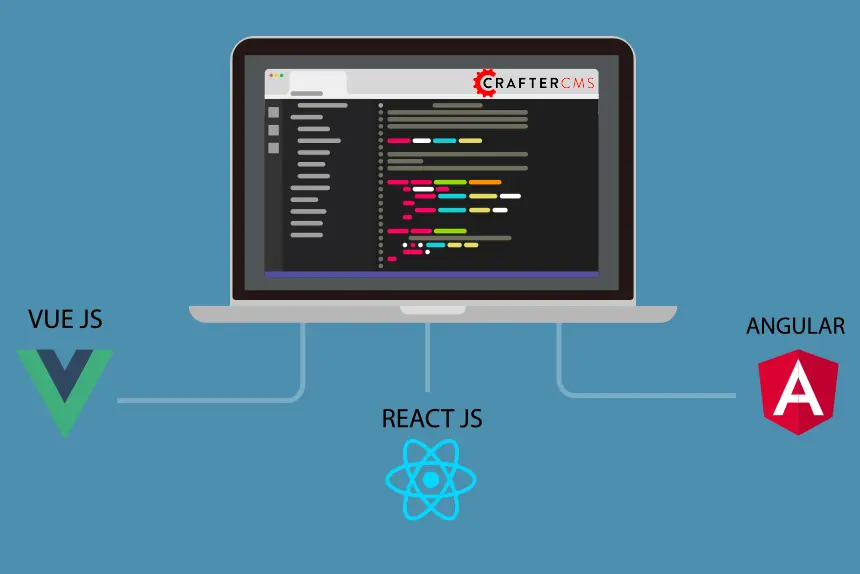Angular vs Vue vs React: What's The Difference?

Sara Williams

When it comes to developing applications for the web, then one thing rings true. JavaScript will be involved in some capacity. After all, it is the language of the web.
Aside from the large community of developers and the low barrier to entry for newcomers, the importance of JavaScript extends far beyond how developers use it.
JavaScript fuels modern web applications that can be used on any device or platform and its frameworks and libraries are paving the way for the future.
Websites today rely on JavaScript. But JavaScript needs to be properly organized and tested to function correctly; hence, the popularity of various client-side frameworks. These frameworks not only provide the tools for building web apps but also for defining how the code gets organized.
If you’ve spent some time with developers you might have heard about some of these frameworks and libraries - we’re talking about Angular, Vue, and React.
But what are each of these frameworks? When should you use each one, and when should you not?
The truth is that the jury is still out on that topic.
The debate of Angular vs. Vue vs. React will continue for some time among developers, but this article should provide some insight into each of them.
We’ll do a deep dive into these three popular frameworks and explain some of their strengths and use cases, as well as how they can be leveraged for your content delivery needs when coupled with a headless CMS such as CrafterCMS.
Angular
First up, we have Angular JS. The structural framework developed and maintained by Google was the first foray into more straightforward methods for creating dynamic web applications.
Angular leverages HTML syntax, but goes a step farther, as it’s made for applications instead of static websites.
It allows you to eliminate excess code through data binding and dependency injection. Angular solves the impedance mismatch between static documents and dynamic applications by creating new syntax through a construct called directives.
Angular has several advantages as a JS framework. Code gets structured conveniently, making it easy to modify and test as necessary. Another thing Angular does well is to remove the tight coupling between the components of an application.
All document object model (DOM) manipulation can, therefore, happen where it should. Without the tightly coupled presentation and application logic, the markup is a lot cleaner and more straightforward.
Therefore, when it comes to building lightweight applications smartly, it pays to go with Angular. The framework lets you create SPAs that are maintainable and easily tested. Thanks to automatic synchronization with two-way data binding, code consistency, and a robust ecosystem with an active community, Angular gets the job done as a JavaScript framework.
Vue
The newcomer to the group, Vue wasn’t initially as standard as React and Angular, but it’s popularity, and use cases continue to grow year over year.
Vue is a progressive framework for building user interfaces. It was designed to be incrementally adoptable, and the core library is focused on the view layer only, making it easy to pick up or integrate with other libraries. It can also be used to create SPAs.
In addition to user interfaces, Vue is also used for developing both desktop and mobile apps and could become even more popular than Angular and React due to its benefits. Library modularization is a standard part of frontend development and is a feature that React and Angular have as well.
However, with Vue, it’s much easier to extend functionalities and have all parts working together once modules are included thanks to its high decoupling. Also, Vue is small in size compared to React and Angular. It’s also straightforward to understand for developers, offers a ton of flexibility and is easy to integrate with other JavaScript applications.
React
Open source JavaScript library React is the oldest of the three as it was first introduced in 2011. The library was created by Facebook and continues to be maintained by them as well. It’s used for building user interfaces for SPAs, handling the view layer for both mobile and web applications.
While Angular and Vue are definitive frameworks, React is considered a library due to the increased flexibility. React lets developers build large apps without having to change data or reload the page - allowing things to be fast and simple. React is known for its simplicity and ease of learning, allowing developers to get started using it quickly.
Creating interactive UIs is what React was built for, updating and rendering the right components for each state in your application. Your code also gets easier to debug as a result of declarative views.
React is component-based, so encapsulated components can manage their own state and then may be combined to create more complex user interfaces. Logic is written in JavaScript rather than templates, so data passes through the app, keeping state out of the DOM.
Which One Is Better?
Now that you know a bit more about these JavaScript frameworks and libraries let’s answer the question. Which one is better for you to use?
A comparison of npm trends over the last six months will show React, leading the pack.
However, the answer will largely depend on what you want to build as they each have their own strengths. Ultimately, there is no wrong choice, and a lot will depend on developer preference.
Angular and React are backed by communities built at Google and Facebook, respectively, but Vue has a large backing within the open source world.
When it comes to developing lightweight applications, Vue and React are the obvious choices, whereas Angular works best for applications with a large user interface.
No matter which framework or library you choose to build your interface with, it’s essential that you also integrate a suitable content management system to deliver content to those interfaces.
Leverage JavaScript Frameworks and Libraries with CrafterCMS
As an open source headless CMS platform, CrafterCMS is used by developers who favor each of these frameworks and libraries for a wide variety of digital experience applications. CrafterCMS is agnostic when it comes to frontend technologies, providing support for all three.
Headless CMSs can only take JavaScript development so far. When a distributed Git-based repository is added, like in the case with CrafterCMS, there’s more fuel added to the development experience. Git makes managing the developer process easy and lets content authors and software developers collaborate across different environments.
With CrafterCMS’s unique support for DevContentOps processes, changes to content and code get reflected across development, staging and production environments instantaneously. This creates a streamlined process that makes it easier for not only software developers, but also marketers and IT operations, to get their jobs done faster and more effectively regardless of which frontend libraries and frameworks you choose.
As new frontend development frameworks emerge and the current ones evolve, CrafterCMS will remain in a unique position to support them all.
Related Posts

Scaling Digital Experiences in EdTech: How Encoura Standardized Content Management with CrafterCMS

Sara Williams

Transitioning the JavaScript SDK to Semantic Versioning

Sumer Jabri

Unveiling the Future of Content Management: Register Now For CrafterCMS Live! 2024

Sara Williams

Headless CMS Use Case: Digital Signage

Amanda Jones
Related Resources
-

Modernizing Video Delivery and Content Management at CPAC, A Canadian Nationwide Broadcaster
Webcast
-

Building React Apps on a Headless CMS
White Paper
-

Building Single Page Apps with React, Headless CMS, and GraphQL
Webcast
-

Where is Headless CMS Architecture Headed?
Webcast
-

A Better Headless CMS for ReactJS Apps
Webcast





